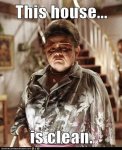One of the interesting creatures I ran across regarding hiding and invisibility is the poltergeist. The poltergeist is a variant of the specter. The poltergeist is invisible. It has a fly speed with hover. It has a forceful slam (melee weapon attack), and a telekinetic thrust (action). It has a dex bonus of +2 and no skills.
I put this creature into a dungeon recently and I'm wondering how the PCs will detect and interact with it. What is used to detect this creature when a PC enters the room that it's located in? It cannot be seen, but maybe it's heard. If it's heard then the only thing heard is the wisps of it's ghostly clothes moving past each other or possibly a clearing of it's ghostly throat?
My current thought is to use the creatures passive stealth score (12) to represent how easy it is to detect. I believe my PCs passive perceptions are all above that value, so it should be a non-issue, but if one character does not have that high of a score would they be able to detect the poltergeist after it makes an attack? It seems clear that if the poltergeist makes a melee weapon attack then the creature that was attacked is aware of the poltergeists location; however, if the poltergeist uses its telekinetic thrust, then it does not make an attack and is thus not revealed.
How would you use the poltergeist in your game and what clearly allows the PCs to detect it?
I put this creature into a dungeon recently and I'm wondering how the PCs will detect and interact with it. What is used to detect this creature when a PC enters the room that it's located in? It cannot be seen, but maybe it's heard. If it's heard then the only thing heard is the wisps of it's ghostly clothes moving past each other or possibly a clearing of it's ghostly throat?
My current thought is to use the creatures passive stealth score (12) to represent how easy it is to detect. I believe my PCs passive perceptions are all above that value, so it should be a non-issue, but if one character does not have that high of a score would they be able to detect the poltergeist after it makes an attack? It seems clear that if the poltergeist makes a melee weapon attack then the creature that was attacked is aware of the poltergeists location; however, if the poltergeist uses its telekinetic thrust, then it does not make an attack and is thus not revealed.
How would you use the poltergeist in your game and what clearly allows the PCs to detect it?


